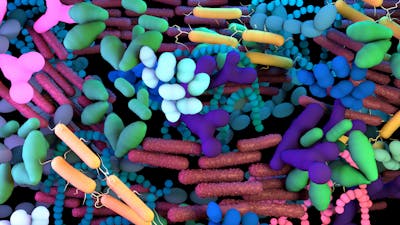- Engineered Live Biotherapeutic Product (eLBP) that can be taken as a safe, oral co-treatment with antibiotics
- Degrades β-lactam antibiotics in the intestinal tract to preserve the microbial balance, while leaving antibiotic concentrations in the blood unchanged
- Prevents the spread of antibiotic resistance
- Simple to manufacture, store, and distribute

Engineered Live Biotherapeutic Product (eLBP) to Protect the Microbiome from Antibiotics
Synthetic biology-driven eLBP as a safe, effective, and inexpensive co-therapy that prevents the loss of health-essential microbial species in the gut during antibiotic treatments
Interested in this technology?
The eLBP team is currently seeking partners in academia and industry to collaborate on further developments.
Living Cellular Devices
Interested in this technology?
The eLBP team is currently seeking partners in academia and industry to collaborate on further developments.
The Problem
Antibiotics not only kill the pathogenic bacteria causing an infection, they also indiscriminately wreak havoc on the trillions of “good” bacteria making up the human microbiome. Known as “dysbiosis,” this alteration of our gut microbial composition manifests as discomforting diarrhea in up to 35% of patients in the short term, and can take months to resolve, often requiring dietary corrections and supplements. However, in some patients, the microbiota can be permanently disturbed, which can lead to a host of autoimmune, metabolic, and neurological diseases. Despite the importance of a healthy gut microbiome for our health, thus far there is no co-therapy that can prevent antibiotic-induced dysbiosis.
Our Solution

Using a synthetic biology approach, Wyss Institute researchers have engineered an eLBP that, when given together with commonly used antibiotics known as β-lactams (which includes the well-known antibiotic penicillin), protects the gut microbiota from dysbiosis. β-lactams make up 65% of the total antibiotics market, and their use is closely linked with the development of antimicrobial resistance, which presents a global health threat.
Usually, antibiotic resistance to β-lactams is conferred by enzymes called β-lactamases, which reside within the bacteria’s cell wall or membrane enclosure where they inactivate β-lactam antibiotics before these reach their targets. β-lactamases are encoded by a single gene that can be passed between bacteria to allow antibiotic resistance to spread in the gut microbial population via horizontal gene transfer.
In designing the eLBP, we tapped into the synthetic biology took kit that we have advanced over the past two decades and enabled Lactococcus lactis, a safe-to-use microbe, to secrete a β-lactamase enzyme that altruistically degrades β-lactams in the bacteria’s environment. The enzyme essentially becomes a ‘common good’ that cannot confer a selective advantage to the producing bacteria or be easily transferred to other bacteria, minimizing the risk and maximizing the clinical benefits of our approach.

To safeguard against the development and spread of antibiotic resistance, the eLBP has various control units incorporated into its β-lactamase expression system. The β-lactamase-encoding gene has been split, and the two halves distributed to different parts of the bacteria’s DNA. This novel biocontainment strategy prevents the spread of β-lactam resistance to other bacteria. The protein products of the split gene are secreted away from the producing bacterial cells, and bind to each other in the bacteria’s outside environment to reassemble a functional enzyme that can degrade β-lactam antibiotics in the gut, protecting its microbial community from antibiotic-induced dysbiosis.
Product Journey
Funded as a Wyss Institute Validation Project, the eLPB was shown in preclinical validation experiments to minimize dysbiosis caused by the antibiotic ampicillin in the gut of mice, and prevented the hostile takeover of the intestine by “opportunistic” Clostridioides difficile bacteria. In addition, it significantly reduced the spread of antibiotic resistance genes within the microbial community of the animals, which usually occurs as a consequence of antibiotic treatments. Crucially, this process does not change the concentration of antibiotics in the bloodstream, allowing them to still effectively treat infections everywhere else in the body.
Interested in this technology?
The eLBP team is currently seeking partners in academia and industry to collaborate on further developments.